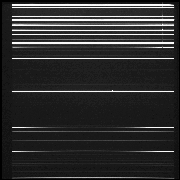CalSpecHeAr
Contents
- Long slit spectroscopy versus SpectroPolarimetry
- Helium-Argon exposure times
- Helium-Argon line identification plots
- Spectral line shift due to CCD distortion
- Internal Reflection
- A sample observing block
Helium and Argon lamps are used to obtain the wavelength calibration of the CCD. The observing template takes an exposure of a Helium lamp followed by an Argon lamp resulting in an image with a combined Helium and Argon spectrum.
Note: One needs to observe He-Ar arcs for every grism used during observations. In general 3-5 exposures at the beginning of the night and an equal number at the end of the night are sufficient. Observers who wish to calibrate "on target" may want to have a separate OB with just 1 exposure.
The y-position of slits vary from one instrumental set-up to another and from one slit to another by a few pixels. So observers must take the calibration frame during their run or risk wavelength uncertainty by a few pixels. However unless the slits are re-inserted the calibration is stable from day to day.
Long Slit versus SpectroPolarimetry
The wavelength calibration for both modes uses the same template. The differences are (see the sample OB below):
- Filter: Free for Long slit spectroscopy while Wollaston Prism for SpectroPolarimetry.
- Star Plate: whatever slit (Slit#??) for Long slit spectroscopy but Wollaston Mask for SpectroPolarimetry.
- Exposure Times: The value for SpectroPolarimetry for any grism should be double the value listed for the same grism for Long slit spectroscopy.
Helium-Argon Exposure Times
The exposure times for the Helium and Argon lamps are different for each grism and have to be specified in the observing template. Important: Always check that your favourite lines are not saturated as the observations are being made.
Spectral line shift due to CCD distortion with rotator angle
The instrument suffers from considerably large flexures. Arcs with grism 20 were taken at several rotator positions. The spectrum taken with rotator angle 174.9 (corresponding to 0 position angle on sky) was cross-correlated with other spectra at 20 degrees step. The spectra were taken with grism #20, i.e. the red VPHG, to have a large dispersion. This plot shows the shift of the spectra in the dispersion direction, which is the y-coordinate on the CCD. Efforts are being made to reduce these flexures, but it is recommended to users looking to measure radial velocities that they take arc lamp exposures after each science frame.
Note that the telescope flexures cause a rigid shift of the wavelength scale. Therefore, it is always a good idea to check the wavelength calibration using the night sky lines and get the average shift, which can be as big as several Angstroms. Correcting for this shift usually gives good wavelength calibration. An atlas of the brightest night sky lines can be found in Osterbrock & Martel (1992).
Internal reflection
Internal reflection (click on link for image). For a few grisms, ghost lines due to internal reflections can be see in the He Ar image. The ghost lines tend to be quite faint and have a different curvature to the real lines. They can be seen at least for grism 12. Nothing much can be done about these, and care must be taken not to misidentify these lines when doing wavelength calibrations.
A sample observing block
jP2PP Panel with Typical Parameters
The above example shows an OB comprising a sequence of:
- Long slit spectroscopy He-Ar arc frames with Grism #6 , Slit 1.5" , normal readout and 2x2 binning followed by
- 3 Long slit spectroscopy He-Ar arc frames with Grism #1 , Slit 0.7" , normal readout and 2x2 binning followed by
- 3 SpectroPolarimetric He-Ar arc frames with Grism #3 , normal readout and 2x2 binning
The FITS image output by the template is named EFOSC_spec_HeAr.#.fits
As an example the following image is given, which shows a Long slit spectroscopy He-Ar arc frame with Grism #6, Slit 1.0", normal readout and 2x2 binning. Click on the image to get a larger version:
Parameter Values: One does not have to (in fact, should not) change the value of any parameter other than:
- Starplate: same as Slit; see the complete Set of Slits available.
- Grism: See the complete Set of Grisms available.
- Exposure Time: See the He-Ar Exposure Times page for a listing of the appropriate exposures for the two lamps (specified separately on the same template).
- CCD readout speed: normal , fast or slow .
- CCD binning: 1x1 or 2x2
- Number of exposures: 3 exposures are sufficient and our experience is that this is stable from one day to another.
